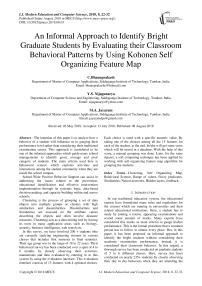An informal approach to identify bright graduate students by evaluating their classroom behavioral patterns by using kohonen self organizing feature map
Автор: C.Bhanuprakash, Y.S. Nijagunarya, M.A. Jayaram
Журнал: International Journal of Modern Education and Computer Science @ijmecs
Статья в выпуске: 8 vol.10, 2018 года.
Бесплатный доступ
The intention of this paper is to analyze how a behavior of a student will influence us in gauging their performance level rather than considering their traditional examination scores. This approach is considered to be one of the informal approaches which guide many school managements to identify good, average and poor category of students. The main criteria used here is behavioral science which explores activities and interactions among the student community when they are inside the school campus. School-Wide Positive Behavior Support can assist in addressing the issues related to the prevention, educational identification and effective intervention implementation through its systemic logic, data-based decision making, and capacity building within and across schools. Clustering is the process of grouping a set of data objects into multiple groups or clusters with high similarities and dissimilarities. Dissimilarities and Similarities are assessed on the attribute values describing the objects and often involve distance measures. Clustering acts as a data mining tool by having its roots in many application areas such as biology, security, business intelligence, web search etc. In this survey, we have involved 200 + students who are currently studying engineering streams in various classes that includes first semester to final semester. Their age group was in the range of 18 to 22 years. Their behavioral survey has been conducted over a span of 4 to 6 months by closely observing their activities, mannerisms and then evaluated by entering in to this system by using the evaluation interface. This evaluation interface consists of 15 features with 4 optional choices. Each choice is rated with a specific numeric value. By taking one of the choices among all the 15 features for each of the student, at the end, he/she will get some score which will be stored in a database. With the help of this score, a manual grouping was done. Later, for the same dataset, a soft computing technique has been applied by working with self organizing feature map algorithm for grouping the students.
Clustering, Self Organizing Map, Behavioral Science, Range of values, Fuzzy predicates, Similarities, Neural networks, Hidden layers, feedback
Короткий адрес: https://sciup.org/15016785
IDR: 15016785 | DOI: 10.5815/ijmecs.2018.08.03
Список литературы An informal approach to identify bright graduate students by evaluating their classroom behavioral patterns by using kohonen self organizing feature map
- Josephine Infantino & Emma Little : “Students’ Perceptions of Classroom Behaviour Problems and the Effectiveness of Different Disciplinary Methods” – The Journal of Education Research, Pages 491 – 508, published online on 19 January 2007.
- Edmund T. Emmer &Laura M. Stough “Classroom Management: A Critical Part of Educational Psychology, With Implications for Teacher Education” – Journal : Educational Psychologist, Volume 36, Issue 2. Pages 102 – 112, published online on 08 June 2010.
- Leslie C. Soodak “Classroom Management in Inclusive Settings” – Journal : Theory Into Practice, Volume – 42, Issue – 4, Pages 327 – 333 Published online 24 June 2010.
- Paul Black &Dylan Wiliam “Assessment and Classroom Learning” - The Journal of Education Research, Pages 7 – 74, published online on 28 July 2006.
- Karin Barac, Marina Kirstein, Rolien Kunz, Bernice Beukes “Factors influencing students’ learning approaches in auditing” – Journal : The Journal of Economic Education, Volume – 23, Issue 23, Published online on 15th July 2014.
- Joyce Phikisile Dhlamini “Management of Learner Discipline in Secondary Schools: A Collaborative Effort”– International Journal of Educational Sciences, Volume 15, 2016 - Issue 3 Published online 25 Sep 2017.
- Md. Saiful Malak, Umesh Sharma & Joanne M. Deppeler “Predictors of primary school teacher’s behavioural intention to teach student’s demonstrating inappropriate behaviour in regular classrooms” - Cambridge Journal of Education, Published online 04 Sep 2017.
- Sue Catherine O'Neill & Jennifer Stephenson “The measurement of classroom management self-efficacy : a review of measurement instrument development and influences ”, - Educational Psychology, Volume 31, 2011 - Issue 3, Published Online: 02 Feb 2011.
- RobynBeaman, Kevin Wheldall & Coral Kemp “Recent Research on Troublesome Classroom Behaviour : A Review”, Australasian Journal of Special Education, Volume 31, 2007 - Issue 1, Published Online: 26 Sep 2007.
- Dr.R.B.V.Subramanyam and A.Goswami : “A Fuzzy Data Mining Algorithm for Incremental Mining of Quantitative Sequential Patterns “ – International Journal of Uncertainty, Fuzziness and Knowledge-Based systems, Vol-13, No-6, 2005, 633-652
- Powers, David M W (2011). "Evaluation: From Precision, Recall and F-Measure to ROC, Informedness, Markedness & Correlation" (PDF). Journal of Machine Learning Technologies 2 (1): 37–63.
- Jiabin Deng, JuanLi Hu, Hehua Chi : “An Improved Fuzzy Clustering Method for Text Mining “ – 2nd International Conference on Network Security, Wireless Communications and Trusted Computing”, 978-0-7695-4011-5/10 @ 2010 IEEE
- Timothy C.Havens, James C.Bezdek, Marimuthu Palaniswami : “Fuzzy c-Means Algorithms for Very Large Data “ IEEE Transactions on Fuzzy Systems, Vol-20, No-6, December – 2012.
- Junli Lu, Lizhen Wang, Yaobo Li :” A Fuzzy Clustering Method Based on Domain Knowledge” – 8th ACIS International Conference on Artificial Intelligence. 0-7695-2909-7/07 IEEE
- Saeed. R. Aghabozorgi, The Ying Wah : “Using Incremental Fuzzy clustering to Web Usage Mining “, International Conference of Soft Computing and Pattern Recognition, 2009


